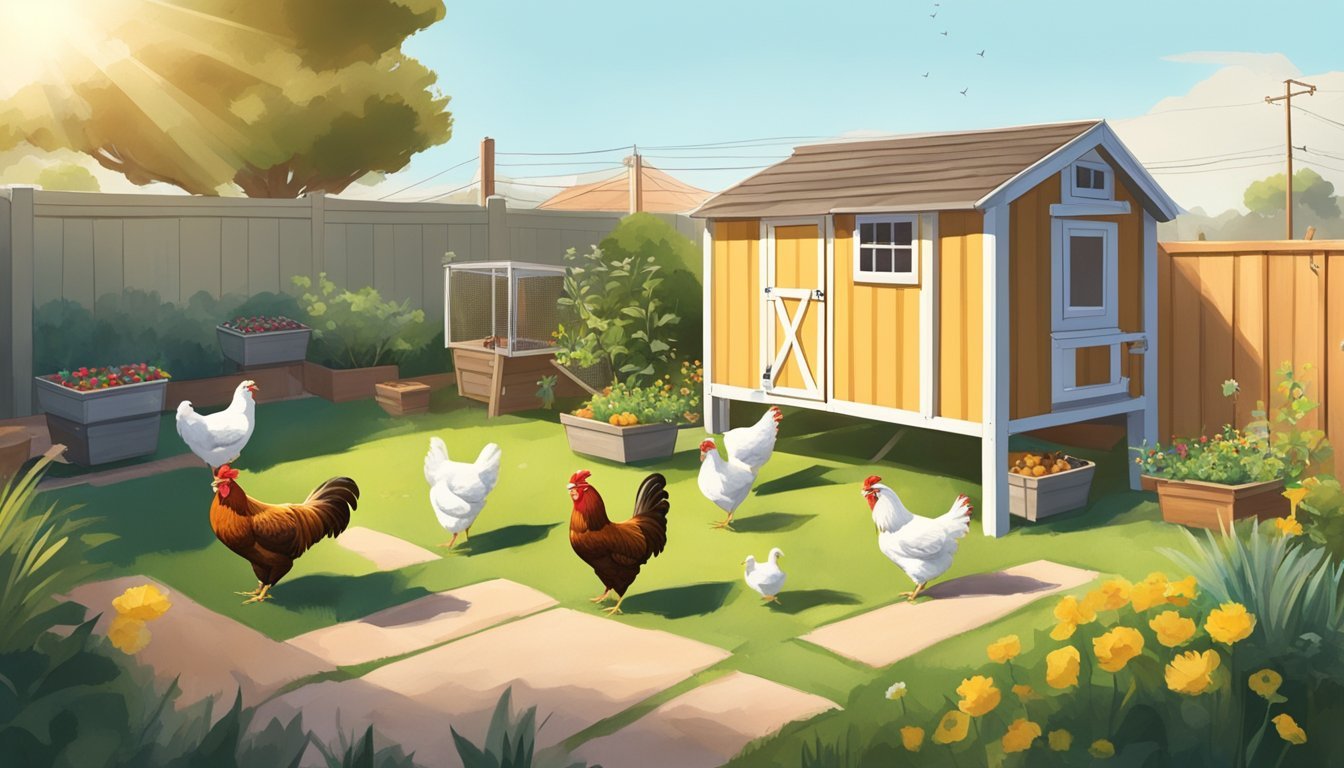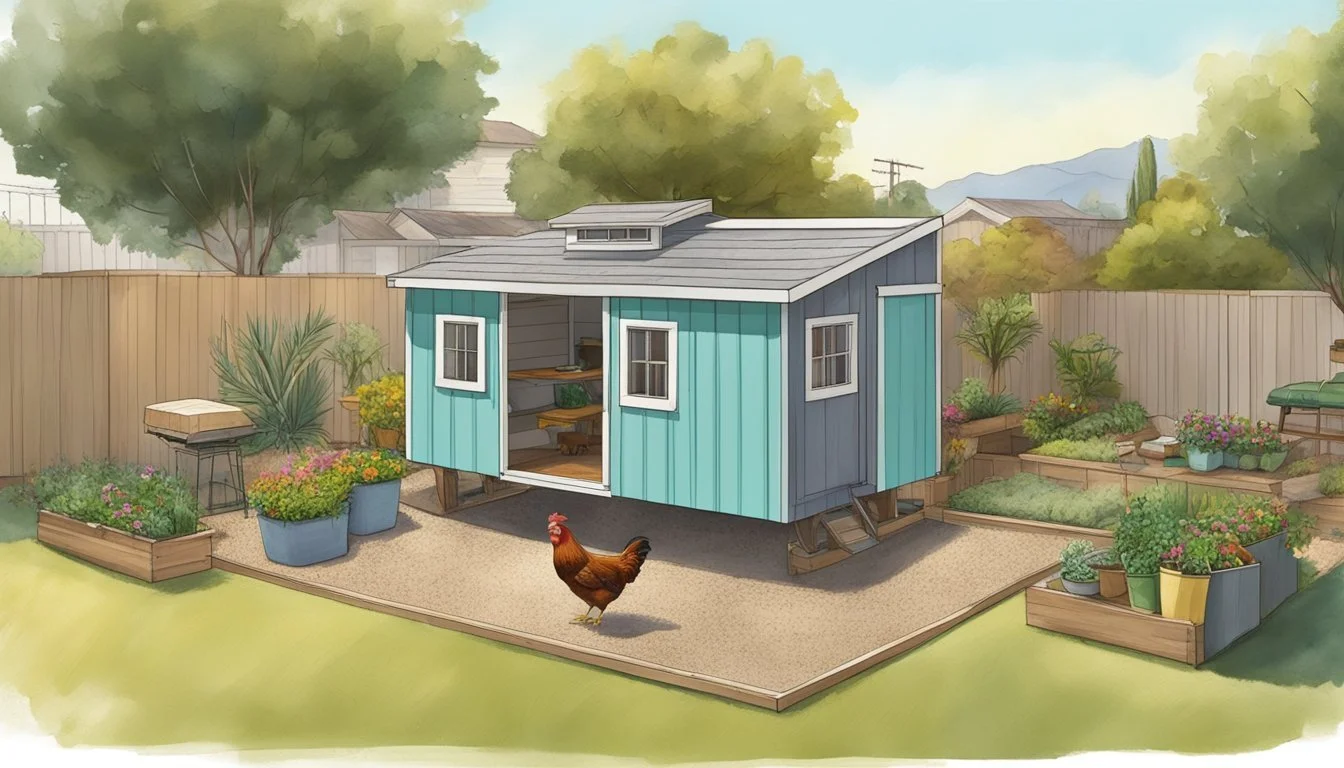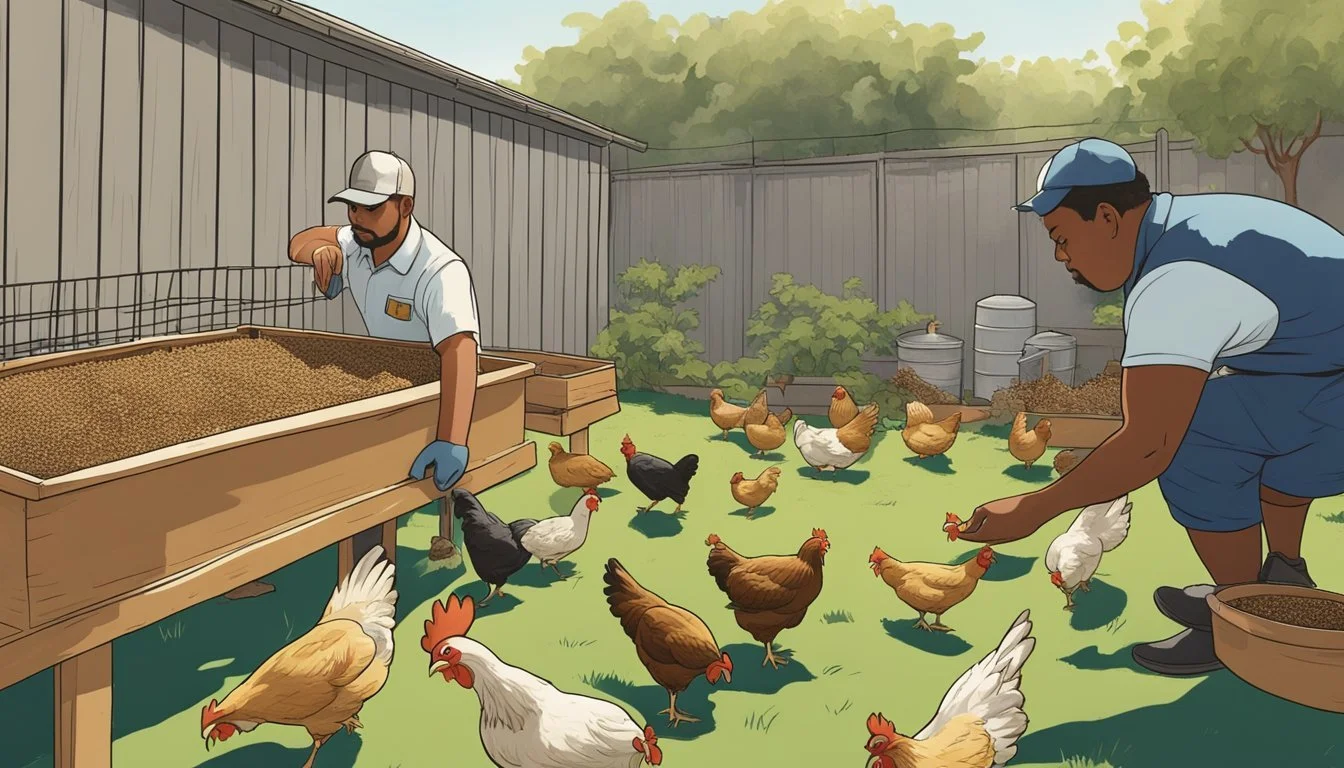Raising Backyard Chickens in East Los Angeles, CA
Urban Farming Essentials
Raising backyard chickens in East Los Angeles, California, offers residents the opportunity to embrace a more sustainable lifestyle while enjoying the pleasure of fresh eggs. The appeal of urban poultry farming has seen a resurgence in recent years, tapping into the broader movement towards local food sources and self-sufficiency. For East Los Angeles inhabitants, understanding and adhering to local ordinances is crucial for successfully integrating chickens into their backyards.
The city’s regulations strike a balance between allowing residents to keep chickens and maintaining neighborhood harmony. Regulations stipulate that chicken coops must be at least 35 feet away from neighboring dwellings, ensuring minimal disturbance to surrounding households. While no permit is specifically required for keeping backyard chickens, the city enforces certain sanitation and zoning standards to prevent health hazards and nuisances, such as pests or odors. Coops are expected to be kept clean, dry, and well-ventilated.
Los Angeles permits the keeping of hens, but roosters are often under tighter restrictions due to their noise. In many neighborhoods, if roosters are allowed, they must be housed at least 100 feet from neighboring structures. These rules aim to preserve the tranquility of the urban environment. Backyard chicken enthusiasts in East Los Angeles are therefore encouraged to educate themselves on the specifics of local regulations and embrace the practice within the framework set by the city, fostering a respectful and rewarding experience in urban agriculture.
Legal Framework for Raising Chickens
In East Los Angeles, California, the legal framework for raising backyard chickens involves adhering to specific local and state regulations that address zoning, the number of chickens allowed, coop requirements, and the obtainment of necessary permits.
Los Angeles Municipal Code
Under the Los Angeles Municipal Code, residents in East Los Angeles must comply with local laws concerning the keeping of backyard chickens. Key provisions include that:
Proximity: Chicken coops must be positioned at least 20 feet away from the owner's dwelling and 35 feet from any other residences.
Number of Chickens: Up to four hens are typically allowed per property, but roosters are often restricted to negate noise issues.
Sanitation: The areas where chickens are kept must adhere to strict cleanliness standards to maintain public health and animal welfare.
These regulations ensure that the noncommercial raising of chickens does not detrimentally impact the community or environment.
California State Regulations
State regulations in California may supplement or override local ordinances, so it's crucial for residents to also be aware of California chicken ordinances. However, most regulations for raising backyard chickens fall under municipal jurisdiction, and the state primarily provides guidelines on health and welfare standards for the animals.
Understanding Zoning and Permits
Each locality may have various zoning areas with different rules for residential and commercial purposes. Chickens could be deemed acceptable in one zone while prohibited in another. East Los Angeles residents should:
Consult the Department of Animal Services or the local zoning office to verify the permissible use associated with their property.
Obtain any necessary permits before setting up a backyard coop to avoid fines or the removal of the chickens.
Residents planning to raise chickens should familiarize themselves with local regulations to ensure they comply and are not subject to enforcement action due to nuisances like noise or sanitation problems. Understanding and following these guidelines helps maintain a harmonious community and a successful backyard chicken venture.
Setting up Your Chicken Coop
Setting up a chicken coop in East Los Angeles requires understanding the local regulations, providing adequate space, and ensuring the safety and cleanliness of the environment for the chickens.
Choosing the Right Location
In East Los Angeles, the right location for a chicken coop must comply with setback requirements. Coops should be positioned at least 35 feet from neighboring structures. This distance increases to 100 feet if a rooster is present. Homeowners should verify local zoning laws to ensure they choose a permissible site within residential areas.
Space and Setup Requirements
The space inside the chicken coop must allow 2-3 square feet per bird, while the outside roaming area should provide 8-10 square feet per bird. This spacing is vital for their ability to exhibit natural behaviors. A coop must be clean and well-ventilated to prevent diseases and to maintain a healthy environment.
Coop Security and Predator Protection
Ensuring that chicken coops are secure from predators is critical. Strong wire mesh and secure doors are necessary to protect the flock from common predators like raccoons and hawks. Regularly inspect the coop for vulnerabilities and maintain it to prevent unwanted access. A coop should provide security while being easy to access for cleaning and maintenance tasks.
Chicken Care Basics
When raising backyard chickens in East Los Angeles, daily upkeep, proper nutrition, and health management are fundamental for a healthy flock.
Daily Maintenance and Sanitation
Chickens require a clean environment to thrive, so daily coop cleaning is essential. Bedding should be kept dry and replaced often to prevent the buildup of waste and odors. Regularly removing droppings helps to maintain sanitation and reduces the risk of disease. It's important to provide adequate ventilation to keep the air fresh and to reduce moisture that can lead to respiratory issues in chickens.
Nutrition and Feeding
Proper nutrition is vital for the growth and productivity of backyard chickens. Feed must be formulated to meet the chickens' developmental stage:
Growers (8-14 weeks): A starter/grower feed with 16-18% protein.
Layers (15-18 weeks and older): A finisher or layer feed with around 16% protein.
Chickens also benefit from access to grit, which aids in digestion, and supplemental calcium, especially for laying hens.
Health Monitoring and Disease Prevention
Regular health checks are necessary for early detection of issues. Observing each chicken for signs of distress, unusual behavior, or changes in eating patterns is important. Effective disease prevention includes:
Vaccinating against common diseases.
Keeping new birds quarantined before introducing them to the flock.
Ensuring feed is free from mold and contaminants.
A proper health regimen and biosecurity measures help prevent the spread of illness.
Chicken Breeds and Life Stages
When raising backyard chickens in East Los Angeles, CA, one must carefully consider the breeds that are best suited to the climate and environment while also understanding the different requirements during each life stage from chicks to mature hens.
Choosing Suitable Breeds
In East Los Angeles, chicken breeds that thrive in a warmer climate, such as the Leghorn or Rhode Island Red, are recommended. These breeds are known for their heat tolerance and consistent egg production. Leghorns are prolific layers of white eggs, while Rhode Island Reds lay brown eggs and are admired for their hardiness.
Raising Chicks and Brooding Practices
After eggs hatch, the chicks must be placed in a brooder with a heat source to keep them warm. The temperature inside the brooder should start at approximately 95 degrees Fahrenheit and be decreased by 5 degrees each week until they are acclimated to the outside temperature. They require 18-20% starter feed during the first 8 weeks and thereafter, a 16-18% starter/grower feed until they reach 14 weeks.
Care for Adult Chickens and Hens
As chickens mature, they need a spacious coop with proper ventilation and suitable nesting boxes for laying eggs. Each hen requires a minimum of 1 to 1.5 square feet of space inside the coop to reduce stress and prevent aggression. Adult chickens should be fed a 16% layer feed to ensure good health and optimal egg production. Regular veterinary check-ups are also essential to monitor for diseases and ensure the overall welfare of the flock.
Neighborhood Dynamics
In East Los Angeles, the dynamics of raising backyard chickens heavily depend on the effective management of noise and maintaining good relationships with neighbors. Addressing potential nuisances proactively can foster a harmonious community environment.
Addressing Noise and Nuisance Concerns
Noise, particularly from roosters, is a primary community concern. Roosters are known for their early morning crowing, which can be disruptive. Local regulations mandate that chicken coops must be situated at least 35 feet from any neighboring structures, a measure designed to minimize disturbance. Keeping coops clean and well-maintained also plays a crucial role in reducing nuisances such as odors or pest infestations. In practice, one should consider:
Positioning coops as far from neighboring homes as possible.
Regular maintenance of the coop to prevent odors and pests.
Avoiding owning roosters; they are discouraged due to their potential for causing excessive noise.
Integrating Chickens Into the Community
Integrating chickens into a neighborhood extends beyond mere compliance with regulations. It involves educating oneself and informing neighbors about the benefits and responsibilities of raising chickens. Neighbors may have concerns about potential impacts on property values or the attraction of predators and pests. Clear communication and transparency can alleviate these concerns. Community integration tips include:
Hosting informational sessions to discuss the positive aspects of raising chickens, like pest control and egg production.
Establishing a neighborhood agreement or guidelines to ensure all parties feel comfortable and respected.
Providing eggs to neighbors as a goodwill gesture to build positive rapport.
By considering the interests of the neighborhood, residents of East Los Angeles can successfully integrate backyard chickens into the fabric of their community.
Enhancing Chicken Welfare
Proper chicken welfare goes beyond mere survival, encompassing physical comfort, environmental stimulation, and the opportunity to engage in natural behaviors like ranging. Providing an enriched habitat and considerate care ensures healthier birds—and often, healthier eggs.
Comfort and Shelter
Chickens require a secure and comfortable coop to protect them from predators and harsh weather conditions. For bedding, pine shavings and straw are preferred materials due to their absorbency and insulating properties. Avoid using kitty litter, as it can be harmful if ingested. The coop should also include a radiant heater or a heating lamp for warmth during colder months, while ensuring proper ventilation prevents moisture and ammonia buildup.
Bedding materials:
Preferred: Pine shavings, straw
Avoid: Kitty litter
Heating:
Radiant heater or heating lamp for cold weather
Ventilation to control moisture and ammonia
Stimulation and Ranging Practices
Chickens flourish when they can exhibit natural behaviors such as foraging and dust-bathing. Ranging practices, where chickens have access to outdoor spaces, can lead to healthier and more flavorful free-range eggs. Provide areas with sand for dust baths, which chickens use for feather maintenance and parasite control. Additionally, integrating toys can stimulate mental activity and reduce stress and pecking orders. Depending on local ordinances, if a rooster is present, ensure that it has enough space to avoid aggressive behaviors typical of overcrowding.
Enrichment:
Sand for dust baths
Toys for mental stimulation
Ranging:
It is essential to range your chickens if space and regulations allow
Benefits include improved health and higher-quality free-range eggs
Productivity and Management
Backyard chicken farming in East Los Angeles focuses on efficient egg production and collection, the regulation of breeding and selling, and the adoption of sustainable practices within urban homesteading.
Egg Production and Collection
When raising chickens for egg production, it is important to provide laying hens with a balanced diet and clean water. Most hens require approximately 16 hours of light per day to maintain optimal egg production. In East Los Angeles, coop design should facilitate easy egg collection and protect eggs from predators. A common practice is designing coops with side-access nests that allow for stress-free retrieval of eggs, which ideally should be collected daily to ensure freshness.
Daily Egg Count: Keep a record to monitor productivity.
Feeder Placement: Position feeders strategically to encourage movement and reduce overcrowding.
Breeding and Selling Chickens
Selling chickens or eggs within East Los Angeles may require adherence to specific local ordinances, including restrictions on the number of poultry one can keep. Responsible - breeders focus on the health and well-being of the birds, with a keen understanding of genetic traits and chicken breeds suitable for urban settings. It should be noted that breeding chickens on a noncommercial scale typically falls under hobbyist activity and may not require special permits. However, selling eggs or poultry does necessitate a Seller's Permit from the California Department of Tax and Fee Administration.
Permitted Breeds: Research city-approved breeds for urban areas.
Marketing: Ethically market your products, emphasizing the benefits of locally-sourced poultry and eggs.
Sustainable Practices and Urban Homesteading
Urban homesteading in East Los Angeles is a growing trend that integrates poultry management with other sustainable practices. Chickens contribute to composting efforts by breaking down organic waste into nutrient-rich compost, which benefits garden soils immensely. Furthermore, chickens that are allowed to roam in a controlled free-range environment tend to produce healthier, more nutritious free-range eggs while decreasing the gardener's reliance on chemical pesticides, as chickens naturally control pests.
Composting: Integrate chickens into composting regimens by allowing them to process food scraps and yard waste.
Free-Range Areas: If space allows, create designated areas for chickens to free-range, contributing to their diet diversity and overall well-being.
Compliance and Etiquette
Raising backyard chickens in East Los Angeles requires adherence to local ordinances and a commitment to maintaining harmony within the community. Compliance with laws and respectful poultry keeping practices are fundamental.
Staying Informed on Updates to Laws
Local Regulations: Individuals should keep abreast of East Los Angeles municipal laws and regulations pertaining to backyard chickens. This includes understanding the specifics of:
Permits: Whether a permit is required for the number of chickens they wish to keep.
Zoning: The applicable zones in East Los Angeles that permit backyard chickens.
Changes in legislation occur, and it's crucial that residents periodically review local laws to ensure continued compliance.
Being a Considerate Poultry Keeper
Responsible chicken ownership extends beyond legal compliance. It includes being courteous to neighboring properties and addressing potential concerns proactively:
Sanitation: Maintain a clean coop to prevent odors and attractants for pests.
Noise Control: Understand and mitigate noise, particularly if considering a rooster, as laws often restrict their presence due to noise concerns.
It's important that poultry keepers avoid neglect and ensure well-being for their chickens, which in turn minimizes disturbances and promotes good relationships within the neighborhood.
Additional Considerations
When raising backyard chickens in East Los Angeles, it's essential to have the right supplies at hand, ensure that your chickens are prepared for emergencies, and engage with local community resources.
Supplies and Accessories
To raise chickens successfully, residents must provide ample access to water through clean water dishes, temperature control mechanisms for extreme weather conditions, and sturdy chicken feeders to prevent waste. An essential list includes:
Water dishes: Clean and refill daily.
Chicken feed: Opt for high-quality feed tailored to your chickens' age.
Chicken feeders: Protects feed from pests and weather.
Coops: Must be predator-proof and provide shelter.
Emergency Preparedness
Chickens require protection from predators such as coyotes and hawks common in urban settings. Additionally, having a plan for temperature extremes is crucial. Owners should undertake:
Regular coop inspections: To fortify against predators.
Temperature control: Solutions like insulation for cold, and ventilation or shade for heat.
Creating an emergency plan for potential health issues or natural disasters is paramount for any poultry owner in urban areas like East Los Angeles.
Involvement in Local Communities
Engagement in local chicken-raising communities can provide invaluable support. Owners can learn more about:
Regulations: From places like Anaheim, Bakersfield, Oakland, Sacramento, San Diego, and San Francisco.
Health and wellness: Sharing knowledge on care and maintenance of backyard chickens as pets.
Local businesses: For purchasing necessary supplies like feeders or fowl-specific needs.
In summary, raising backyard chickens in urban environments like East Los Angeles involves preparation, knowledge of local regulations such as those in neighboring areas like Anaheim and Bakersfield, and a commitment to animal welfare.











